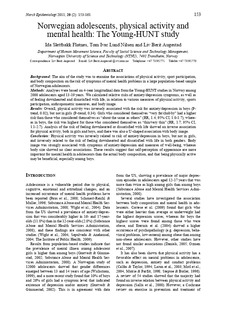| dc.description.abstract | Background: The aim of the study was to examine the associations of physical activity, sport participation, and body composition on the risk of symptoms of mental health problems in a large population-based sample of Norwegian adolescents.
Methods: Analyses were based on 4-year longitudinal data from the Young-HUNT studies in Norway among 2000 adolescents aged 13-19 years. We calculated relative risks of anxiety/depression symptoms, as well as of feeling downhearted and dissatisfied with life, in relation to various measures of physical activity, sports participation, anthropometric measures, and body image.
Results: Overall, physical activity was inversely associated with the risk for anxiety/depression in boys (Ptrend, 0.02), but not in girls (P-trend, 0.34). Girls who considered themselves “very fat/chubby” had a higher risk than those who considered themselves as “about the same as others” (RR, 1.4; 95% CI, 1.0-1.7), whereas in boys, the risk was highest for those who considered themselves as “thin/very thin” (RR, 1.7; 95% CI,
1.1-2.7). Analysis of the risk of feeling downhearted or dissatisfied with life showed an inverse association for physical activity, both in girls and boys, and there was also a U-shaped association with body image.
Conclusion: Physical activity was inversely related to risk of anxiety/depression in boys, but not in girls, and inversely related to the risk of feeling downhearted and dissatisfied with life in both genders. Body image was strongly associated with symptoms of anxiety/depression and measures of well-being, whereas body size showed no clear associations. These results suggest that self-perception of appearance are more
important for mental health in adolescents than the actual body composition, and that being physically active may be beneficial, especially among boys. | nb_NO |

